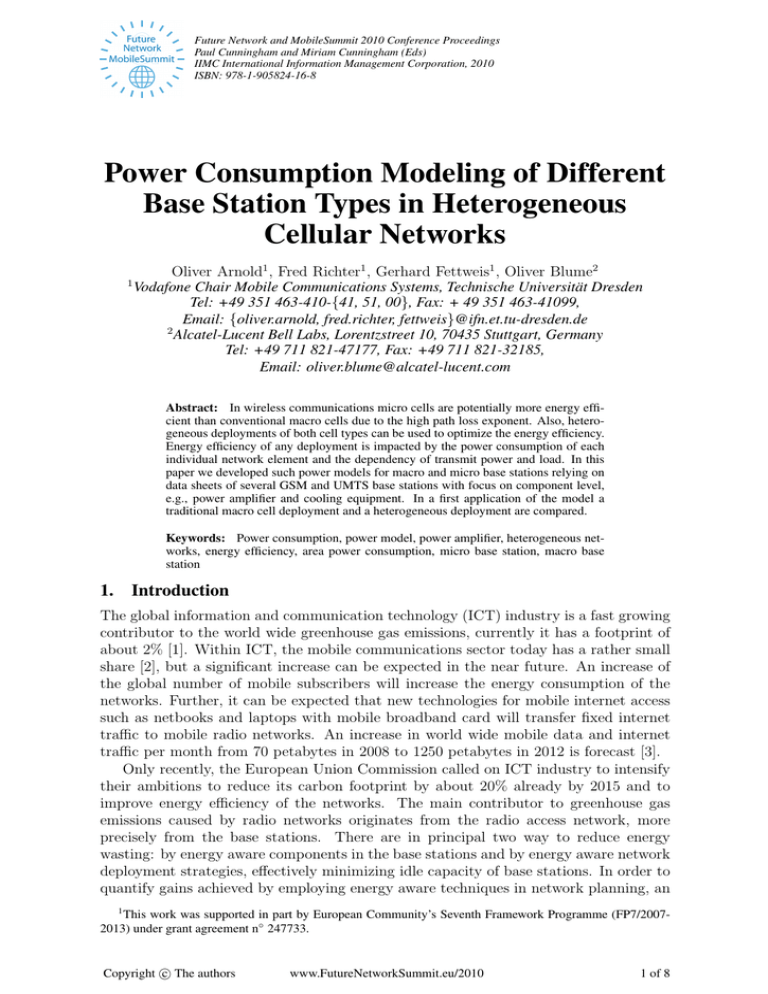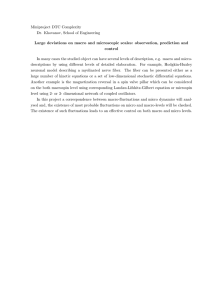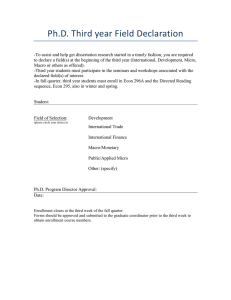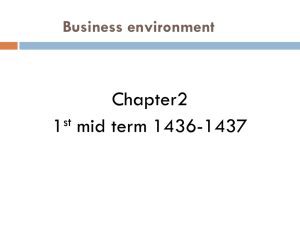Power Consumption Modeling of Different Base Station Types in
advertisement

Future Network and MobileSummit 2010 Conference Proceedings
Paul Cunningham and Miriam Cunningham (Eds)
IIMC International Information Management Corporation, 2010
ISBN: 978-1-905824-16-8
Power Consumption Modeling of Different
Base Station Types in Heterogeneous
Cellular Networks
1
Oliver Arnold1 , Fred Richter1 , Gerhard Fettweis1 , Oliver Blume2
Vodafone Chair Mobile Communications Systems, Technische Universität Dresden
Tel: +49 351 463-410-{41, 51, 00}, Fax: + 49 351 463-41099,
Email: {oliver.arnold, fred.richter, fettweis}@ifn.et.tu-dresden.de
2
Alcatel-Lucent Bell Labs, Lorentzstreet 10, 70435 Stuttgart, Germany
Tel: +49 711 821-47177, Fax: +49 711 821-32185,
Email: oliver.blume@alcatel-lucent.com
Abstract: In wireless communications micro cells are potentially more energy efficient than conventional macro cells due to the high path loss exponent. Also, heterogeneous deployments of both cell types can be used to optimize the energy efficiency.
Energy efficiency of any deployment is impacted by the power consumption of each
individual network element and the dependency of transmit power and load. In this
paper we developed such power models for macro and micro base stations relying on
data sheets of several GSM and UMTS base stations with focus on component level,
e.g., power amplifier and cooling equipment. In a first application of the model a
traditional macro cell deployment and a heterogeneous deployment are compared.
Keywords: Power consumption, power model, power amplifier, heterogeneous networks, energy efficiency, area power consumption, micro base station, macro base
station
1.
Introduction
The global information and communication technology (ICT) industry is a fast growing
contributor to the world wide greenhouse gas emissions, currently it has a footprint of
about 2% [1]. Within ICT, the mobile communications sector today has a rather small
share [2], but a significant increase can be expected in the near future. An increase of
the global number of mobile subscribers will increase the energy consumption of the
networks. Further, it can be expected that new technologies for mobile internet access
such as netbooks and laptops with mobile broadband card will transfer fixed internet
traffic to mobile radio networks. An increase in world wide mobile data and internet
traffic per month from 70 petabytes in 2008 to 1250 petabytes in 2012 is forecast [3].
Only recently, the European Union Commission called on ICT industry to intensify
their ambitions to reduce its carbon footprint by about 20% already by 2015 and to
improve energy efficiency of the networks. The main contributor to greenhouse gas
emissions caused by radio networks originates from the radio access network, more
precisely from the base stations. There are in principal two way to reduce energy
wasting: by energy aware components in the base stations and by energy aware network
deployment strategies, effectively minimizing idle capacity of base stations. In order to
quantify gains achieved by employing energy aware techniques in network planning, an
1
This work was supported in part by European Community’s Seventh Framework Programme (FP7/20072013) under grant agreement n◦ 247733.
c The authors
Copyright www.FutureNetworkSummit.eu/2010
1 of 8
appropriate energy efficiency metric must be defined. One important figure of merit is
the energy consumption of a network. In this work the electrical input power of macro
and micro base stations in cellular mobile radio networks is characterized and quantified
in dependence of the load level. The model parameters are derived according to values
found in literature and by interviewing experts. With this, the power consumption of
heterogeneous systems can be determined with different mixes of macro and micro base
stations.
The remainder of the paper is organized as follows. In Section 2 some general
remarks, assumptions, and insights are given. The power consumption model for macro
base stations is introduced, followed by the power consumption model for micro base
stations. In Section 3 the parameters of the two power models are qualified. In Section 4
some applications of the power models are provided. Section 5 concludes the paper.
2.
Power Model
The main goal of the power consumption model we describe in this paper is to make
realistic input parameters available for the simulation of total network power consumption in mobile communication networks and to compare different heterogeneous cell
deployments. In Table 1 the main parameters are summarized. It can be seen that this
set of parameters determines the input values for a network architecture only, i.e., further parameters are required. These additional parameters are fixed for each simulation
and are determined by the technology, environmental conditions which are important
for cooling, etc..
The power consumption of a base station consists of two parts, modeled concurrently.
The first part describes the static power consumption, a power figure which is consumed
already in an empty base station. Depending on the load situation, a dynamic power
consumption part adds to the static power.
In this paper we derive a power model for typical base stations as deployed today.
These provide a relative small dynamic contribution to power consumption and the
optimum cell size is strongly affected by the static part. We will compare the result to
today’s macro cell deployment.
In the future, base stations will become more energy efficient. The items with the
highest impact on a base station’s power consumption are the following: utilization
of remote radio heads or ordinary power amplifiers with corresponding feeder losses,
different kinds of cooling (air conditioning, air circulation, or free cooling), site sharing (especially regarding infrastructure), and number of carrier frequencies. It can be
expected that the average power consumption requirement per bit decreases in the following years due to new technologies. For instance, the introduction of the gallium
nitride power amplifier at the end of 2010 is expected.
2.1 Assumptions
The power consumption of a base station varies over time. Several modes can be
distinguished. Therefore, the power consumption depends on the mode of the base
station (finite state machine). A base station can be in an operational or in a nonoperational state. Furthermore, in an operational state different conditions can be
distinguished, e.g., a low traffic and a peak traffic mode are available. Between all
states a transition time is needed to reach the new state, e.g., the power-on of a base
station needs a dedicated amount of time and energy. If the accumulated time in a
c The authors
Copyright www.FutureNetworkSummit.eu/2010
2 of 8
Parameter
NSector
PTX
PSP
CPSBB
Table 1: Linear power model parameters
Description
Parameter
# sectors
Tx power
Signal processing overhead
NPApSec
µPA
CC
Description
# PAs per sector
PA efficiency
Cooling loss
Battery backup and power supply loss
dedicated mode is larger than all transition times, which we assume for our modeling,
then these transition times can be disregarded. For ease of modeling all transition states
are omitted. The timing behavior of a base station is illustrated in Figure 1.
In all scenarios the backhaul requirements are considered to be similar and to scale
with the user density, where the backhaul is assumed to be power neutral among the
scenarios. We are aware that the backhaul is interesting from the OPEX point of view
(rental, wired vs. wireless). Nevertheless, the backhaul aspect is not considered in this
evaluation due to the focus on the technical aspect.
2.2
Components
Power Amplifier The power amplifier (PA) is expected to work in a state in which
the peak value of the signal corresponds with the possible peak power of the PA. Thus,
the efficiency can be maximized. Doherty and Gallium nitride (GaN) PAs have the
potential to improve the efficiency. They are especially suited for LTE with its high
crest factor compared to GSM, where a constant envelope modulation technique is
employed (Gaussian Minimum Shift Keying: GMSK). In the following we refer to the
ratio of transmit power to direct current input power when speaking of power amplifier
efficiency.
Signal Processing UMTS signals are much more complex than GSM signals regarding the signal processing on transmitter and receiver side, whereas LTE signals are even
more complex. Thus, the signal processing per link is substantially increased.
A/D Converter An A/D converter consumes less than 5% of a macro base station’s
input power. Thus, it is not regarded and assumed to be included in the signal processing part.
Antenna The Antenna gain is included in the link budget. It is not explicitly
modeled in this section.
Figure 1: Timing behavior of base stations
c The authors
Copyright www.FutureNetworkSummit.eu/2010
3 of 8
Feeder The feeder loss is about 3 dB in a macro base station. It is included in the
link budget as well. Thus, it will not be regarded in the power consumption model.
Power Supply and Battery Backup The loss within these two components is typically
between 10% and 15% and depends mainly on the employed technology. By using 10%,
an optimistic value is assumed.
Cooling As stated before, cooling mainly depends on environmental conditions.
Values between zero (free cooling) and 40% can be found.
2.3 Macro Base Station Power Model
In [4] measurements regarding the power consumption of deployed GSM and UMTS
base stations are shown. The measurements were taken over a period of several days.
It can be seen that the power consumption varies about 3% for a UMTS and 2% for
a GSM base station over time. In contrast to that, the data traffic varies between no
load and a peak load level. Due to the negligible amount of dynamic power, the power
model of today’s typical macro base station can be reduced to the static part. Base
stations with dynamic power saving features have appeared only very recently [5] and
are not yet wide spread in the networks.
The efficiency of a power amplifier on the input side is mainly determined by the applied modulation schemes and by its crest factor. For modeling the power consumption,
the following formula is used:
PTX
+ PSP · (1 + CC ) · (1 + CPSBB ) .
(1)
PBS,Macro = NSector · NPApSec ·
µPA
2.4 Micro Base Station Power Model
A micro base station is considered to consist of one sector containing one PA. The
load varies between no load and full load, represented by 0 and 1, respectively. The
power amplifier has a decreased efficiency compared to the PA of a macro base station.
No pre-distortion is applied. A PA efficiency of 20% is assumed. Nevertheless, in
comparison to the macro base station the absolute power consumption is reduced due
to the smaller coverage area and thus much smaller transmit power requirement. The
power consumption is of more dynamic nature, because for a small cell the number
of users is statistically varying stronger and this makes it attractive to adapt the PA
during a time period with lower load.
PBS,Micro = Pstatic,Micro + Pdynamic,Micro .
(2)
It is assumed that the digital part scales according to the number of active links. Thus,
the number of frequency and time slots will impact the power consumption of this part.
In [6] a mobile WiMAX base station is described. It is stated, that the baseband card
consumes 28% of the total power in typical cases and 32% in peak cases. The increase
between typical and peak power consumption of the baseband card is 100%.
The digital baseband is the main contributor to the dynamic part of the power
consumption of a micro base station. This is regarded in the power model by varying
the power consumption according to the load. No battery backup is typically needed
for micro base stations. The power supply loss is approximately 10% and depends on
the technology. Air condition is not required for a micro base station. The several
c The authors
Copyright www.FutureNetworkSummit.eu/2010
4 of 8
Table 2: Micro base station power model parameters
Parameter
Description
Parameter
Pstatic,Micro
PTX
NL
CTX,NL
PSP,NL
Stat. power consumption
Max. tx power per PA
# active links
Dyn. tx power per link
Dyn. signal processing per link
Pdynamic,Micro
µPA
CTX,static
PSP,static
CPS
Description
Dyn. power consumption
PA efficiency
Stat. tx power
Stat. signal processing
Power supply loss
parameters are listed in Table 2. Summarizing the properties of a micro base station,
we can derive the formula for the static power consumption as
PTX
CTX,static + PSP,static · (1 + CPS )
(3)
Pstatic,Micro =
µPA
and for the dynamic power consumption by
PTX
Pdynamic,Micro =
(1 − CTX,static ) · CTX,NL + PSP,NL · NL · (1 + CPS ) .
µPA
3.
(4)
Results
In [7] the power consumption figures on component level of UMTS and GSM base stations are compared, where each base station is considered to consist of three sectors.
Firstly, a high capacity (six carrier frequencies per sector, GSM1) and a medium capacity (two carrier frequencies per sector, GSM2) GSM macro base station are compared.
A power amplifier efficiency of 35% is given. Secondly, an UMTS base station with one
carrier frequency per sector (UMTS1) and a power amplifier efficiency of 15% is considered. Another UMTS base station type is described in [8] with focus on component
level. Three sectors are employed, each containing two carrier frequencies (UMTS2).
Unfortunately, there is no statement about cooling. Thus, cooling is assumed to be
20%. By using the given values, an adaptation to the power model is possible. In
Table 3 the parameter subset for the considered macro base stations are summarized.
In the application scenario LTE macro and micro base stations are used. The
macro base station consists of three sectors, each containing two power amplifiers. The
power amplifiers’ efficiency is set to 38%. Considering the high crest factors of LTE,
these PAs are assumed to work near their peak output values. For signal processing
PSP = 58 watt are assumed. Thus, signal processing is expected to be efficient. Cooling
accounts for 20 percent (CC = 0.29), power supply and battery backup amount to 10%
(CPSBB = 0.11). The transmit power is adapted to the required base station’s coverage
area. For instance, for macro cells with inter site distance of 1500 m the required
transmit power is about 24 watt, yielding a total power of about 950 watt.
For the LTE micro base station one sector and one power amplifier is used. The PA
has an efficiency of 20%. For the number of active links a maximum of 25 is assumed,
which corresponds to employing a 5 MHz bandwidth LTE system with a FFT size of
512, resulting in 300 subcarriers and, thus, 25 resource blocks of 12 subcarriers each.
Further values are: CTX,static = 0.8, CTX,NL = 0.04, PSP,static = 15 watt, PSP,NL = 0.55 watt,
and CPS = 0.11. Note that these figures are used in the following section.
c The authors
Copyright www.FutureNetworkSummit.eu/2010
5 of 8
Table 3: Macro base station power model parameters, adapted from [7] and [8]
PBS
NSector NPApSec
PTX
µPA
PSP
CC CPSBB
GSM1
GSM2
UMTS1
UMTS2
3700 W
1430 W
1450 W
1568 W
3
3
3
3
6
2
1
2
40 W
40 W
40 W
20 W
35%
35%
15%
40%
36.4 W
54.8 W
73.5 W
127.7 W
0.23
0.27
0.28
0.29
0.11
0.11
0.11
0.14
As in the case of macro base stations, the transmit power is adapted to the base
station’s coverage area. For a cell size of 100 m a transmit power of about 2 watt is
sufficient.
4.
Application Scenarios
Considering transmit power figures only is not a suitable approach when the focus is on
energy efficiency, especially for heterogeneous networks. It is obvious that any energy
efficiency metric on radio network level should comprise a network’s power consumption,
which in turn depends on the transmit powers of each individual base station within
the network. Now, the power models developed in this work allow for computing the
total power consumption heterogeneous networks simply by summation of the power
consumption figures of each macro and micro base station in the network, where the
latter dynamically adjusts to the current traffic demand.
When an operator wants to provide services in a given area, the question arises how
many base stations he should deploy in order to minimize the total power consumption,
i.e., what is the optimal compromise between larger inter site distances, hence, less
base stations with larger transmit powers, and shorter inter site distances yielding
more base stations with smaller transmit power figures. In [9] the notion of area power
consumption of a cellular network was introduced. It was shown that for a hexagonal
deployment the area power consumption metric yields an optimal inter site distance.
The proof is based on the fact that the path loss (and thus the transmit power) increases
faster with the inter site distance (power of the the coefficient is larger than 2) than
the covered area (power coefficient of 2). For small cells the static part of the power
becomes dominant and this leads to a minimum in total network power consumption.
For visualization purposes consider a cellular network with macro base stations located on a hexagonal grid with a specific inter site distance. Further, let a micro base
station be placed on each corner of the Voronoi region according to the hexagonal
grid. In Table 4 the features of the two base stations and a typical mobile terminal
are summarized. In this regard, the micro base stations are considered to overlay the
macro network, hence do not contribute to the coverage, but to capacity. Further, we
employ a transmit power of about 2 watt for the micro base stations, which yields a
cell size of about 100 m according to the macro base station’s transmit power. Based
on propagation models taken from [10], we compute the necessary transmit power as
described in [9], where we define coverage by a minimal receive signal level (per subcarrier) of about -120 dBm according to the link budget provided there. Results for the
two considered deployments, pure macro network and macro network with micro base
stations within, are depicted in Figure 2. We can observe a minimum at 1500 m inter
site distance for the homogeneous macro scenario which matches the typical value of
coverage oriented macro cell deployments. This confirms the used power model. For
c The authors
Copyright www.FutureNetworkSummit.eu/2010
6 of 8
Table 4: Base station configuration
# Antennas (per sector) # Sectors Antenna gain
Macro BS
Micro BS
MS
2
1
1
3
1
–
15 dBi
2 dBi
-1 dBi
Noise figure
4 dB
4 dB
7 dB
the heterogeneous deployment the micro cells act as energy efficient coverage extension
and shift the minimum to about about 1600 m.
However, the static power term of the additional micro base stations obviously
adds to the macro deployment, thus the heterogeneous area power consumption is
always higher than for the pure macro deployment. It is obvious that the area power
consumption figure can not be the exclusive metric describing energy efficiency since it
does not take into account the provided additional network capacity and higher system
spectral efficiency. Nevertheless, this metric makes it possible to evaluate different
network topologies with similar performance figures with regard to energy efficiency.
5.
Conclusions and Outlook
In this paper we have developed a power consumption model for macro base stations
which comprises of a static power consumption part only. In contrast to that, a power
consumption model for micro base stations additionally consisting of a dynamic power
consumption part was derived. Based on data sheets of several GSM and UMTS base
stations we were able to qualify the various model describing parameters, providing a
tool for simulative investigations from an energy efficiency perspective. We have applied
this power consumption model and could show that for conventional macro base station
deployments the widely used inter site distance of 1500 m is most energy efficient. An
overlay of micro base stations at the cell edge allows to shift the optimum inter site
distance to slightly larger values.
The investigations and results at hand are currently being further developed and
dealt with in more detail within the consortium of the FP7 project “Energy Aware
Radio and NeTwork TecHnologies (EARTH)”. The main focus of the project is on the
important issue of energy efficiency of mobile broadband systems with special emphasis
on energy efficient deployment strategies and network architectures. The proposed
Figure 2: Area power consumption as function of inter site distance for different deployments
c The authors
Copyright www.FutureNetworkSummit.eu/2010
7 of 8
power consumption model for macro and micro base stations is a first step towards
evaluating energy efficiency of heterogeneous deployments, which is a most promising
strategy for improving a system’s capacity while reducing a cellular network’s energy
demand. Within EARTH, we will adapt the power model to future base stations which
are designed to have higher power consumption dependency on the load situation.
Moreover, new metrics regarding coverage and capacity will be defined. They are
applied to analyze which base station deployment strategies provide the best energy
efficiency for these metrics.
The technological basis for a massive energy efficiency increase in the ICT sector,
e.g., green communications and energy efficient cellular and sensor networks, is also the
aim of the Spitzencluster “Cool Silicon”, funded by the German government.
6.
Acknowledgements
This work has been performed within close bilateral cooperation among Alcatel-Lucent
Bell Labs and Technische Universität Dresden. The authors would like to acknowledge
the contribution of their colleagues to share a common view from both sides, industry
and academia.
References
[1] McKinsey & Company, “The impact of ICT on global emissions,” tech. rep., on
behalf of the Global eSustainability Initiative (GeSI), November 2007.
[2] G. P. Fettweis and E. Zimmermann, “ICT energy consumption - trends and challenges,” in Proceedings of the 11th International Symposium on Wireless Personal Multimedia Communications, (Lapland, Finland), September 2008.
[3] L. Howard, “The Mobile Internet Transformation,” December 2008.
[4] A. Corliano and M. Hufschmid, “Energieverbrauch der mobilen Kommunikation Schlussbericht,” February 2008. In German.
[5] “Alcatel-Lucent demonstrates up to 27 percent power consumption reduction on
base stations deployed by China Mobile.” Press release, Mobile World Congress,
Barcelona, February 17, 2009.
[6] Intel, “A Solar-Powered WiMAX Base Station Solution,” December 2006.
[7] C. Forster, I. Dickie, G. Maile, H. Smith, and M. Crisp, “Understanding the Environmental Impact of Communication Systems - Final Report,” April 2009.
[8] G. Fischer, “Future Challenges in R&D with respect to mobile communication
basestations,” tech. rep., Bell Labs Research, January 2008.
[9] F. Richter, A. J. Fehske, and G. P. Fettweis, “Energy efficiency aspects of base station deployment strategies in cellular networks,” in Proceedings of the 70th Vehicular
Technology Conference (VTC Fall), September 2009.
[10] Technical Specification Group Radio Access Network, “TR 36.814 - Further Advancements for E-UTRA: Physical Layer Aspects (Release 9),” tech. rep., 3rd
Generation Partnership Project, 2009.
c The authors
Copyright www.FutureNetworkSummit.eu/2010
8 of 8






